At KIST, students complete two important diagnostic assessments at the beginning of the school year. One is academic from the United Kingdom Standards and Testing Agency. The other is a Student Survey which allows the learning community to evaluate our classroom environment.
On the academic tests, only 12% of my class achieved ‘just below expectations’ and only 8% were in reading and math. That result indicated to me that academics were an area of strength and that interventions would be needed on a limited and individual basis. With differentiation strategies in place, a classroom culture that would cultivate peer support and collaboration would be helpful to increase the depth and quality of learning.
Turning attention toward the student survey, I identified two major areas of concern that could potentially derail academic progress and achievement.
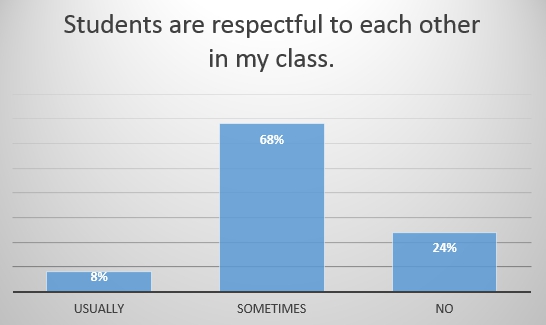

For details on the survey, view my previous post, Student Survey Analysis 2016.
This post will focus on an action plan to improve classroom climate and morale with the goal of increasing academic achievement through increased enthusiasm and positive engagement.
Mindfulness
As detailed in the post, Elementary mindfulness, daily meditation is one strategy that could contribute to a more reflective classroom climate. However, such negative survey results showed a need for a targeted intervention with the goal of helping students to be more Reflective.
Community Circle
Another important opportunity for reflection is our weekly Community Circle. To help my class understand the importance of reflecting together, we elevated Community Circle to a top priority. On top of never cancelling or shortening our sessions, I devised an evaluation system by which active participation results in a ‘meeting expectations’ grade in Listening and Speaking. Knowing that their contributions as members of a community was being monitored, students practiced more intent listening and thoughtful speaking.
Positive reinforcement
I set a goal to award at least one IB Learner Profile Award or PYP Attitude Certificate to each student as quickly as their actions and choices would allow. The result was over 100 being awarded and received, and every student received at least one. To provoke parent encouragement, every award was accompanied by an email to the student’s parents with a photo of them receiving it and a description of how it was earned.
The importance of being reflective
The most precise tool in this plan was to create an opportunity for students to reflect on the way the listen and speak to each other. After collaborating with my grade level team about the questions, the result was a G4B Daily kindness and respect reflection form. Completing the form was assigned as home learning every school day for three months. My assumption was that over time, regular reflection would increase students’ mindfulness to help them to improve their communication and interpersonal interactions.
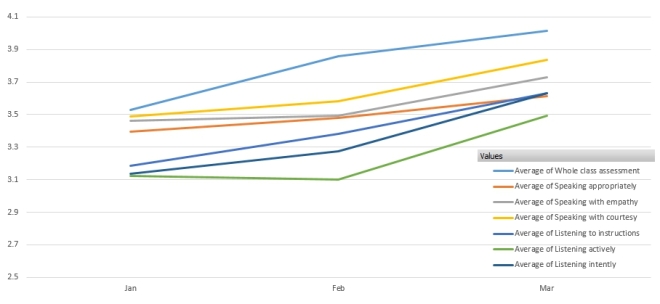
The form was submitted over 800 times and the results were a satisfactory upward trend. A short term intervention might produce more dramatic results, but would not necessarily produce a lasting outcome. These data demonstrate collective and gradual improvement. It also shows that students were generally more critical of themselves than the class as a whole, and that they each improved in relation to their peers.
Listening
The most encouraging results were in the domain of listening. The class showed greatest improvement in listening actively and intently, two skills with a clearly causal connection to academic achievement.
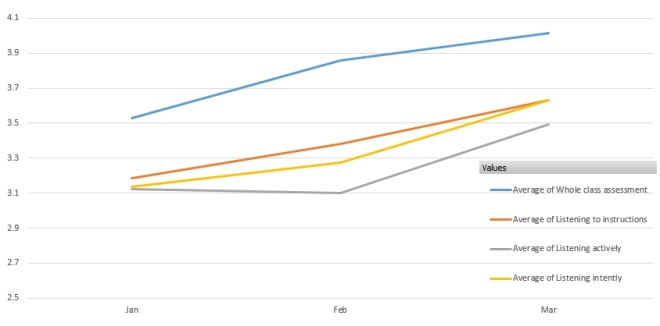
High risk cases
Using the academic diagnostic assessment results to identify ‘high risk’ students, I made a point of checking their reflections occasionally and conferencing with them to increase awareness of their own behavior.
Student A
The first case is a student who is well known for having attention challenges as well as socially awkward patterns of behavior, as well as ‘just below expectations’ results on at least one diagnostic assessment.
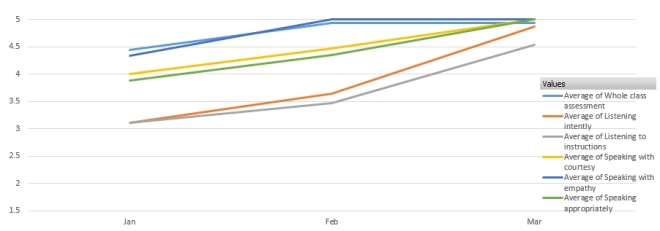
Interestingly, the results clearly converge, indicating that this student believes that their behavior has improved to more closely match their perception of the class. I have observed this to be true anecdotally, as well, as students in the class have taken responsibility for helping this student to interact more productively and follow directions more consistently.
Student B
Another ‘at risk’ student took a very different journey. This may be the only example of a student rating the class lower than themself at the beginning of the survey.
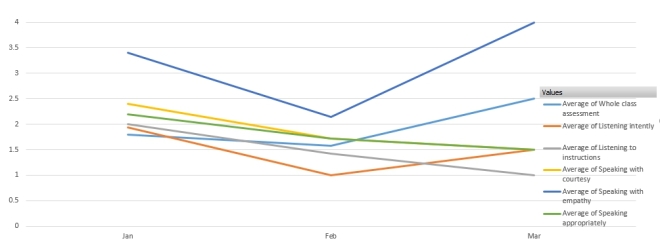
There are students who could reasonably evaluate their own behavior as being better than the class as a whole. Unfortunately, this student is not one of them. We discussed his reflections in detail and there were many instances when I pointed out when choices, ranging from playing with a pencil case to shouting over group members during discussions, were examples of poor listening. The result seems to be increased awareness of their own actions, resulting in a dramatic drop in scores, followed by improvements illustrated by increases in some areas.
Student C
Another student who is not achieving academically has also had several issues outside of class related to inappropriate use of language. This is another case in which these reflections may have served as a ‘reality check’.
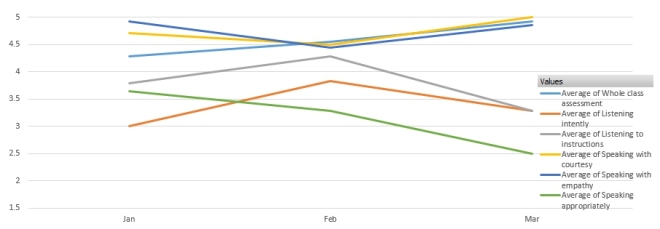
What is most interesting about this case for me is in which areas this student felt they were doing well and comparing that to their evaluation of the class. At first, two speaking categories were higher than the class, yet the scores converge at the end while the remaining areas dropped.
Are results like these desirable? If the goal is increased awareness, and there is a clear problem, then reflections that become gradually more negative could show increased awareness or acceptance of the problem.
Student D
Some students were not ‘at risk’ based on their diagnostic assessments, but warrant special attention for other reasons. The next student is well known, if not notorious, for being at the center of most episodes of misbehavior and interpersonal drama in our class.
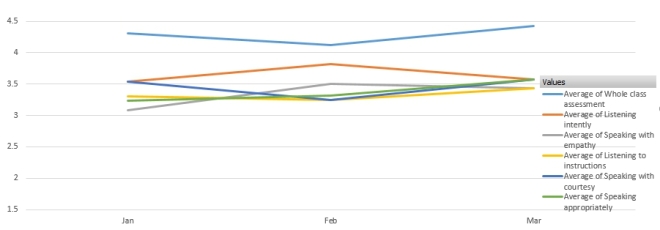
Interestingly, they seem to accurately assess that their behavior is less kind and respectful than the class as a group. Yet, I am struck by the ambiguity of the self reflections. There doesn’t appear to be any strong trend and the averages of the scores simply converge at 3.5 at the end. This is a case that raises more questions than answers, the most important being whether the student is very aware of their choices, but simply failed to make or observe any progress. It’s also possible that these results could indicate a deep lack of mindfulness about the student’s own actions and interactions with others.
It is possible that a differently designed reflection tool could reveal more insights into this case.
The following graphs are included simply because the look fascinating. The first shows a strange consistency, yet also a clear trend of improvement.
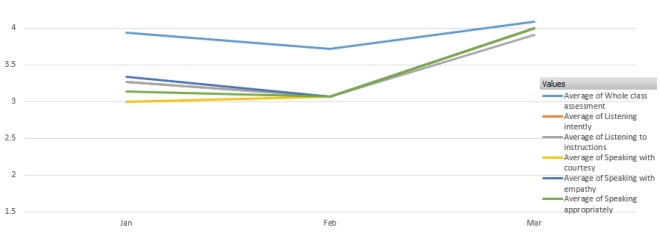
Next, here’s another example of consistency based on category and gradual progress.
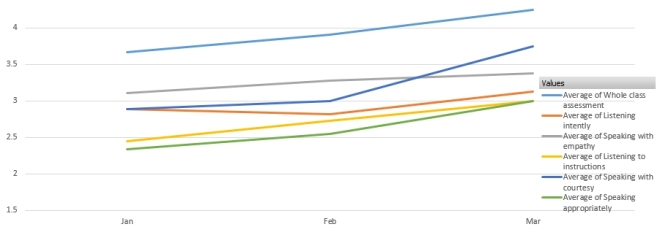
Result
At the end of the three months, I asked the students to answer the original questions of concern: ‘Students are respectful to each other in my class.’ and ‘Students’ behave appropriately in my class.’ This survey was random, like the initial one.
The results are improved, but much more dramatically than I expected.
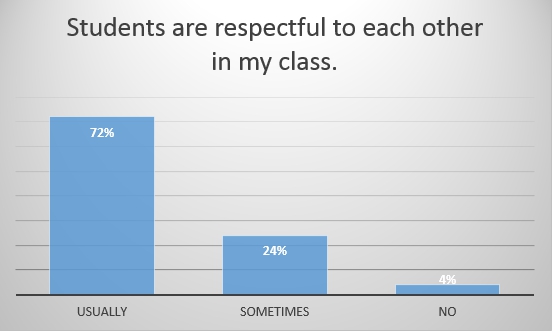
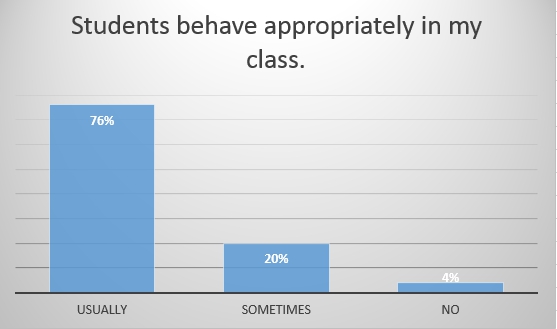
There has been a fundamental shift in behavior and the perception of behavior in my class since the beginning of the school year. While it is impossible to attribute the change to any one variable, it is safe to say that all efforts to increase kindness and respect had a cumulative effect.
And so much of what we do can’t make it onto graphs and charts, but knowing that your students view the space as respectful is key to setting the environment for community and learning. Kindness and caring? Those two elements mean everything.
Kevin
LikeLiked by 1 person